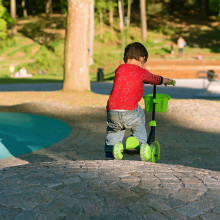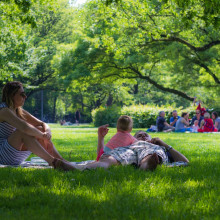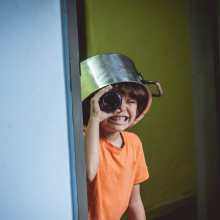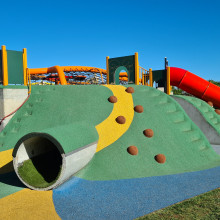Child's play: curtailing a health crisis
Children’s wellbeing is in a state of emergency. It’s a fact that has been tragically overlooked for some time now. In the UK, 41% of children are classed as overweight or obese by the time they leave primary school. Meanwhile, demand for mental health services is at an all time high.
One of the central pillars to any child’s development is play: a necessity for good physical and mental health. You’d have thought, given the crisis we face in children’s health, ensuring kids have the proper provisions to do what comes naturally to them, to play freely, would be a top priority. Unfortunately, this is not always the case.
We've spoken to children’s health and play experts to find out how kids currently growing up in the UK are being failed. We’ll outline the importance of reinstating children’s licence to make the most of the physical environments they occupy, and discover what we must do to encourage that natural spirit of exploration and adventure in our youngsters, or else risk allowing play to become a privilege.
In this episode

01:04 - Waistline worries
Waistline worries
Andrea Smith, MRC Epidemiology University of Cambridge
Here to explain why the language used to describe young people’s health has turned quite so grave, and put some numbers on this is Andrea Smith, from the MRC’s Epidemiology Unit at Cambridge University where she specialises in children’s health...
Andrea - When we think about child physical health, one of the main indicators that we can look at is childhood obesity. The UK national child measurement programme released some data which showed that we have seen the highest annual rise in childhood obesity rates in the last decade. So we now know that by the time a child starts primary school, nearly 28% of children already have obesity or are overweight. And by the time that they leave primary school, just under 41% already have childhood obesity or are overweight, and these numbers really speak to a grave scale of the problem. Childhood obesity of course, is shaped by many complex factors, but during the pandemic, all children were told to stay at home and were losing out on a lot of other social structures and systems.
Chris - I recall seeing the report that was titled 'The State of the Nations' Waist Lines', which actually predated the pandemic. And in that we saw this already happening. So we can't just blame COVID for this. So why are we seeing this inexorable and now accelerating rate of childhood obesity in such young kids?
Andrea - So when we look at trends in childhood obesity, there is a huge divide in terms of social deprivation. So we know when we look at these numbers that children living in the most deprived areas are actually twice as likely to have childhood obesity compared to children who live in less deprived areas. And when we look at the numbers, we can also see that actually ethnicity is also closely linked to child weight with particularly black children more likely to be living with obesity.
Chris - And what do you attribute that to?
Andrea - So we know that deprivation affects health behaviours. So families that are struggling to put aside money to purchase healthy foods are more likely to resort to higher calorie and less nutrient dense snacks. They are also less likely to have extra money to put into expensive hobbies. So children tend to have less higher quality diets and also tend to move less, which overall results in a positive energy balance, which increases their risk for childhood obesity.
Chris - But we have always had people who are poorer in society. So if it was purely how well off you are, then surely we should have seen this trend a long time ago. And we didn't, it's much more recent than that, isn't it? So there must be other factors alongside the very important issues of deprivation and the points you've made.
Andrea - Of course. So this goes hand in hand with changes in our environment. So we know that our current environments are incredibly what we like to call "obese-ogenic." They make very palatable and high energy dense foods easily available, and they make movement less appealing and less of an easy option, which results in an overall positive energy balance.
Chris - What about the other important thing we raised at the top of the programme, Andrea, which is mental health and ill health what's happening there.
Andrea - So of course physical and mental health are closely related in lots of different ways, but we also can see from data that were released by the health foundation that, as a result of the pandemic, a lot more children and young people have been accessing mental health services. And this speaks to the loss of their usual routines and usual support mechanisms and their ability to connect with friends. And I mean, one only has to think of back in deep, dark lockdown days where we lost the ability to have contact with friends. And I think this is really important in the early years where social contact is very important for mental health.

06:21 - Providing children with places to play
Providing children with places to play
Helen Griffiths, Fields in Trust
Andrea has outlined how important physical activity will be to any improvement in the mental and physical health of our youngsters. To facilitate this, kids need places to play. Unfortunately, we don’t always make it as easy as we should. “Fields in Trust” is a charity which aims to legally protect our parks and green spaces, working with landowners and local authorities to ensure these sites are reserved for public recreational use indefinitely. Helen Griffiths, chief executive and a member of the government’s Parks Access Group, told me why their work is so crucial…
Helen - So at Fields in Trust, we've done some research into this to try and look at what the overall provision of parks and green space access looks like across the whole of the country. And we know that approximately 3 million people live more than a 10 minute walk from a local park or green space. And that 10 minute walk metric is a really important one because if it's within a 10 minute walk, then you are more likely to use that space on a regular basis. And that's also particularly relevant when we are thinking about access for children, as they begin to forge some independence. the fact that those spaces need to be within a safe and walkable distance from where they live. There is lots of variation across the piece. And that's really interesting when we also start to think about where those inequities of provision are, because we know again from our green space index that those areas that perform worse in terms of the amount of green space provision that they have, 40% of those are in the highest priority areas for the government's levelling up agenda. So we know that there is a correlation between those areas of deprivation, those more challenged communities, and not having good access to outdoor green space, which is really important when we think about the fact that one and eight households also don't have access to a private green space. So if you don't have a garden or a yard at home, the park is so much more important. It is your back garden.
James - What you are saying is that it's not all down to the pull of being indoors, to the pull of the games console or the iPad, but being pushed away from playing outside because of the limitations on access to parks and green spaces. It worries me as well, what you were saying about the inequalities - families from lower incomes who are bearing the brunt of this, those without access to gardens, which follows because they're the ones who are suffering at the moment, those children with the poorest physical and mental health. We can all agree that having access to green space must have some health benefits, but quantifying that must be tricky. Have you tried?
Helenn - You're completely right in that it is a very difficult issue to be able to put some numbers on. How do you value that service that by its very nature needs to be free at the point of of access. So we have done some studies to try and be able to create a more robust business case. So what is the value of our parks and green spaces - how can we quantify that value so that we can make a better case for investment in them? We've looked at the wellbeing value that is generated by parks and green spaces, and it is enormous. So the wellbeing value is a whopping 34.2 billion pounds a year. And we arrived at that by looking at the ONS questions around subjective wellbeing. So what would it cost us to replace that wellbeing with the whole of the population, if we needed to, if we didn't have access to those spaces? I think there's also a question around making sure from a behavioural perspective that we are encouraging children to be able to use those spaces and that they feel safe in those spaces. And obviously parents are a big part of that in encouraging their children to participate in play and to take risks as part of that developmental piece that is so important as part of children's play.

10:33 - Lack of play harms children's development
Lack of play harms children's development
Samantha Brown, New Ark & Lily Fitzgibbon, University of Stirling & Robert Dighton, ELHAP
That last point Helen made, about children being given the freedom to use play areas whenever, and in whatever way they see fit, is central to this next part of the programme. That’s because we’re going to be talking about adventurous or risky play.
For those not entirely familiar with those terms, all will soon be made clear. I was lucky enough to be able to visit a special facility here in Cambridgeshire, the New Ark Adventure Playground in Peterborough. I spoke to some adventure play experts, as well as some adults who have been studying and working in the area for years…
Samantha - Hello, my name's Samantha Brown and I'm the manager of New Ark.
Lily - I'm Dr. Lily Fitzgibbon. I'm a researcher of child development in the Division of Psychology at the University of Stirling.
Robert - My name is Robert Dighton and I'm the chief executive at ELHAP. ELHAP is one of very few adventure playgrounds set up and designed for disabled children. Originally, adventure playgrounds were built in bomb sites, and the idea was that it was a space where children could build and destroy their own play spaces. They were the masters of their own play destiny. So it is quite a revolutionary concept. The adventure play is a microcosm of the play that we used to do 30, 40 years ago without giving it a name. It's the play that, as children, most of us encountered when we'd play in the streets, by the rivers, in the forests. It was a sense of freedom, a sense where we learn our own limits, our own potential, our own abilities and disabilities. It was playing freely away and outside of the adults world.
Lily - It's the kind of play that makes children shriek or bunch up their hands in excitement. But the idea is that they're, they're taking some risks, but they're managing those risks themselves.
Samantha - Children come in and the very first time they look at the adventure playground and it's like 'wow'. They're in awe basically with what they see and, through supervised risky play, they can extend their learning and social skills.
Robert - All children are experiencing a play deprivation. You think play is a recreational and leisure term isn't it? It feels such a luxury. We know that anybody working in play understands for adventure playgrounds, right through to play therapy and child psychotherapy. We know that play is a serious business. It's an essential component to childhood. There's a risk aversion, generally. There's a kind of burgeoning problem in that parents don't want their children to play outside in the streets, or certainly not in rivers and in forests as I did as a child. So children's worlds are restricting. They are becoming smaller and smaller each year and COVID, I think, accelerated that massively.
Lily - So in some theoretical work led by Professor Helen Dodd, she suggested that adventurous play is a means for children to learn how to cope with the kinds of physical sensations and emotional experiences that they might have in their everyday lives. By having these experiences in a kind of positive playful environment, they learn how to cope with them. And then if they come across them in more difficult situations, then they may be more resilient. And so we suggest that through these mechanisms. Adventurous play may be a means of reducing or protecting children from anxiety.
Claudia - Yeah, my name's Claudia
James - And how old are you?
Claudia - I am nine, turning ten this year
Brooke - Brooke.
James - And how old are you Brooke?
Claudia - 11.
Brooke - 11.
James - <laugh> it took you a minute there. And what do you think? What do you make of it since you've been here?
Brooke - So that black slide over there?
James - Yeah, tell me about it.
Brooke - So basically, we have these cones that are near those tires, which is my other favourite thing. But we also have those cones where we can just originally just spin around on it, on the floor. But we usually take them over to the black slide over there. We go backwards or forwards on it and we just roll down on it. It's fun, but dangerous as well.
James - It looks a bit dangerous. Have you hurt yourself doing it yet?
Brooke - Yeah. I got a headache but I always laughed every time I ever fell.
Claudia - I really liked the zip line, but sadly it was broken and then-
James - Do things get broken quite a lot?
Claudia - Yeah.
Brooke- We found this blue bucket and we can hide our whole entire body inside of it. So then we're also-
James - I saw you chucking yourself down the slide and it's just your legs poking out the end of it.
Claudia - I haven't had myself badly, but I've chipped one of my nails. And bent my nails.
James - Ouch.
Claudia - Well, I really like the swings. I mean I've stumbled over a few times. Maybe got a few bruises and a few scratches, but nothing too serious.
James - That's good to hear. What about playing at school, playing at home or how does it compare to playing here? Is this way better?
Claudia - This is way better and at home there's not really, you can't fit like a whole playground in your backyard.
James - Yeah. How do you feel about the fact that not all kids get to play at a playground like this?
Claudia - Well, I mean, it's a bit sad because without this, let's say you are stuck at home. You're bored. You have nothing to do. Whereas here you can get out exercise, play a lot.
Lily - Our data really suggests that children from underprivileged backgrounds have the most to gain from access to these adventurous play spaces or places that avoid adventurous play like green spaces. And so they also are likely to have the most lose in terms of both their physical and mental health. So it's really crucial that these kinds of spaces remain open and that children from lower income backgrounds continue to have access to them, that they don't just become a kind of luxury of the financially secure.
Robert - Well, there's a problem in that there is no funding, and play was always seen as a kind of a luxury. And it's to our detriment. We could quadruple our services and I don't think we'd touch the sides.
Samantha - We have been fortunate enough to have received funding from the local authorities. Unfortunately, they have not got the funds within their budget to be able to fund us anymore. And we understand that and we are doing all that we can to ensure the future of New Ark.

17:49 - Finding new ways to promote adventurous play
Finding new ways to promote adventurous play
Tim Gill
One of the topics that keeps on coming up again and again is the idea that children are now growing up in a gilded cage. We protect them, but we're doing that at their cost. So what sort of damage are we potentially doing to children by doing this? Chris asked Tim Gill, an independent researcher and writer, and a global advocate for children’s play. He’s the author of Urban Playground: How Child Friendly Planning and Design Can Save Cities...
Tim - I think what's happening is that well-meaning attempts by adults - parents and others - to protect children from all possible harm is actually depriving children of the kind of experiences that, in reality, help them to learn how to cope and to get along in an uncertain world. And I think that there's always a balancing act here, but for some decades I would say, culturally there's been a shift towards what I sometimes call a philosophy of protection and that we need instead to remind ourselves of the value of allowing children to find out for themselves how to get along, how to deal with challenges and how to cope with tricky situations.
Chris - Indeed, one of our other producers on the programme said that when she was little, she used to go out and play on the street and it wasn't until 10 o'clock at night and Mum would call out the window time to come in and everyone would come in. You just don't see that sort of behaviour anymore.
Tim - Yes. I think I talk in my work about the shrinking horizons of childhood and that in children's everyday lives have become more and more constrained and more watched over by adults. That's really a longstanding trend which goes back generations as you've hinted and there are complex reasons for that. I actually think that the physical qualities of neighbourhoods are one of the factors; traffic is a real and present danger for children in many neighbourhoods, and in many neighbourhoods has been growing. But I think there is also this cultural shift that we've just talked about around an overprotective mindset with children. And those two things come together and children are the ones who lose out.
Chris - Andrea was saying at the beginning that this is most marked in terms of physical ill health and mental ill health amongst the poorest communities. Does that apply necessarily here though? Because is it that the kids with better off parents are more likely to have a cushioned life and therefore may be more at risk of having their horizons blunted in the way you're describing?
Tim - Well, it's certainly true that the everyday freedoms that children have vary from place-to-place and with different children, and ages. Also girls have much less freedom than boys and that I think is significant. We don't know enough about some of the social class aspects of this. It'd be easy to turn to stereotypes. My hunch is that - if I could put it this way - outdoor play culture is more resilient in some pockets of towns and cities than others, perhaps for a combination of reasons. Partly because of the physical properties of those neighbourhoods, maybe traffic isn't such an issue, or there are good green spaces nearby, maybe also partly for cultural and social reasons to do with the level of trust and the kind of contact between families. I wouldn't want to make any wider generalisations than that.
Chris - It sounds like the sort of growing up equivalent of the champions of the hygiene hypothesis, who say, we all need to play in dirt more because that's why we're seeing loads of allergies. Our obsession with sterility is giving our immune system nothing to do. This seems like the behavioural equivalent of that. So what sort of solutions can you foresee that would be easily implementable to row back onto this corner we've painted ourselves into?
Tim - I think that's quite a good analogy by the way, and I'd say a couple of things, especially there are opportunities in schools for instance, to open up school break times and lunch times to bring in a bit more adventurous and challenging free play. There are actually hundreds of schools across the UK now that are doing things like bringing in scrap materials and junk; something that's not a million miles away from that adventure playground scene that we heard earlier. And teachers and school leaders are seeing amazing results in terms of children's behaviour and enjoying their school life more. So that's one side. I think there's also really interesting work and I'm promoting some of it in my own work around making neighbourhoods more child friendly. Tackling traffic, opening up green spaces, making it easier to walk and cycle around neighbourhoods, even simple things like having sessions maybe once a week where the through traffic in a street or through traffic outside a school is stopped for a few hours simply so that children can come out and play. It's a model that's been promoted by a charity called Playing Out based in Bristol. And again, that's been taken up by communities across the UK and beyond. So I think there are promising green shoots about how at different levels; parents, communities, decision makers and councils; can make a difference here.
Chris - It's good that we've recognised that there is a problem, and perhaps we are at a turning point. Tim Gill, thank you.










Comments
Add a comment